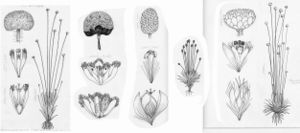Difference between revisions of "Syngonanthus flavidulus"
in H. G. A. Engler, Das Pflanzenreich 13[IV,30]: 256. 1903.
FNA>Volume Importer |
imported>Volume Importer |
||
| (6 intermediate revisions by 2 users not shown) | |||
| Line 1: | Line 1: | ||
{{Treatment/ID | {{Treatment/ID | ||
|accepted_name=Syngonanthus flavidulus | |accepted_name=Syngonanthus flavidulus | ||
| − | |accepted_authority=(Michaux) Ruhland | + | |accepted_authority=(Michaux) Ruhland |
|publications={{Treatment/Publication | |publications={{Treatment/Publication | ||
| − | |title=in H. G. A. Engler,Das Pflanzenreich | + | |title=in H. G. A. Engler, Das Pflanzenreich |
|place=13[IV,30]: 256. 1903 | |place=13[IV,30]: 256. 1903 | ||
|year=1903 | |year=1903 | ||
}} | }} | ||
| − | |basionyms={{Treatment/ID/ | + | |special_status={{Treatment/ID/Special_status |
| + | |code=F | ||
| + | |label=Illustrated | ||
| + | }}{{Treatment/ID/Special_status | ||
| + | |code=E | ||
| + | |label=Endemic | ||
| + | }} | ||
| + | |basionyms={{Treatment/ID/Basionym | ||
|name=Eriocaulon flavidulum | |name=Eriocaulon flavidulum | ||
|authority=Michaux | |authority=Michaux | ||
| + | |rank=species | ||
| + | |publication_title=Fl. Bor.-Amer. | ||
| + | |publication_place=2: 166. 1803 | ||
}} | }} | ||
|synonyms={{Treatment/ID/Synonym | |synonyms={{Treatment/ID/Synonym | ||
|name=Paepalanthus flavidulus | |name=Paepalanthus flavidulus | ||
|authority=(Michaux) Kunth | |authority=(Michaux) Kunth | ||
| + | |rank=species | ||
}} | }} | ||
|hierarchy=Eriocaulaceae;Syngonanthus;Syngonanthus flavidulus | |hierarchy=Eriocaulaceae;Syngonanthus;Syngonanthus flavidulus | ||
| Line 37: | Line 48: | ||
-->{{#Taxon: | -->{{#Taxon: | ||
name=Syngonanthus flavidulus | name=Syngonanthus flavidulus | ||
| − | + | |authority=(Michaux) Ruhland | |
| − | |authority=(Michaux) Ruhland | ||
|rank=species | |rank=species | ||
|parent rank=genus | |parent rank=genus | ||
| Line 49: | Line 59: | ||
|distribution=Ala.;Fla.;Ga.;N.C.;S.C. | |distribution=Ala.;Fla.;Ga.;N.C.;S.C. | ||
|reference=None | |reference=None | ||
| − | |publication title=in H. G. A. Engler,Das Pflanzenreich | + | |publication title=in H. G. A. Engler, Das Pflanzenreich |
|publication year=1903 | |publication year=1903 | ||
| − | |special status= | + | |special status=Illustrated;Endemic |
| − | |source xml=https:// | + | |source xml=https://bitbucket.org/aafc-mbb/fna-data-curation/src/2e0870ddd59836b60bcf96646a41e87ea5a5943a/coarse_grained_fna_xml/V22/V22_160.xml |
|genus=Syngonanthus | |genus=Syngonanthus | ||
|species=Syngonanthus flavidulus | |species=Syngonanthus flavidulus | ||
Latest revision as of 20:29, 5 November 2020
Herbs, perennial, cespitose, rosulate, 5–30 cm. Stems contracted or elongate to 5 cm, chaffy. Leaves: principal leaves mostly spreading-recurved, narrowly linear, 2–6 cm, base pale, apex narrowly acute to subulate, abruptly dilated, surfaces nearly glabrous or grading to copiously hairy. Inflorescences: scape sheaths erect or narrowly ascending, as long as leaves, proximal surfaces glabrous or scattered glandular-pilosulous; scapes filiform, to 1 mm wide, pilose, hairs variably ascending to spreading, translucent, pubescence increasingly glandular distally; mature heads white or yellow-white (aging dull white or pale gray), hemispheric to globose, 5–10 mm wide; receptacle densely pilose, hairs translucent, sharp; involucral bracts ascending, later spreading to recurved, lance-oblong or narrowly ovate, larger ones 3 mm, margins entire, apex acute, glabrous; receptacular bracts absent. Staminate flowers: sepals pale translucent, spatulate to oblanceolate, 2–3 mm, apex acute, adaxially pilose distally; androphore 2.5 mm, hairy at base; petals pale yellow, short-triangular. Pistillate flowers: sepals pale, translucent, linear or narrowly oblong, 3 mm, apex acuminate, surfaces glabrescent; petals connivent or connate above ovary forming beaklike apex, pale, narrowly linear, 3 mm; gynophore hairy; style with apex unappendaged; stigma branches exsert, linear. Seeds translucent brown, ovoid, 0.5 mm, finely longitudinally lined, very finely cross-lined, apex apiculate.
Phenology: Flowering spring–early summer.
Habitat: Moist sands of bog and pond edges, ditchbanks, pine savanna, sandhills ecotones
Elevation: 0–200 m
Distribution

Ala., Fla., Ga., N.C., S.C.
Discussion
Selected References
None.
